1990 British Grand Prix race report - Decline and Fall
Hard enough to get to the top of any activity, especially Grand Prix racing, but it is even harder to stay at the top, because once there no-one will help you stay there, everyone tries to pull you off your pedestal from all sides. In his book The Racer Hans Ruesch described the problem of the man at the top when he said: “When you are on a pedestal you must always look down, for there will be fingers appearing over the edge of the pedestal, trying to drag you down. You must stamp on those fingers before they get a hold . . .”
In 1951 Grand Prix racing reached a climax when the all-conquering Alfa Romeo team were beaten for the first time since 1939. It was something that people following the sport closely could see coming, though few people wanted to believe it. In 1990, again at Silverstone, the all-conquering McLaren-Honda team were soundly beaten after a run of almost unbroken domination of nearly five years. In 1951 the team that beat Alfa Romeo was Ferrari, in 1990 the team was again Ferrari and that fact on its own is worthy of note.
The British Grand Prix at Silverstone saw Ayrton Senna and McLaren-Honda miss out on pole position on the starting grid for the third time in succession, the last two occasions being to Nigel Mansell and Ferrari, and at the end of the day on July 15 the McLaren-Honda-Senna combination had lost out for the third successive race, and each defeat was by Prost and Ferrari. There was usually a good reason, like the punctured tyre in Mexico or the fumbled pit-stop in the French Grand Prix, but at Silverstone there were no extenuating circumstances. The all conquering McLaren-Honda-Senna triumvirate were beaten without question.
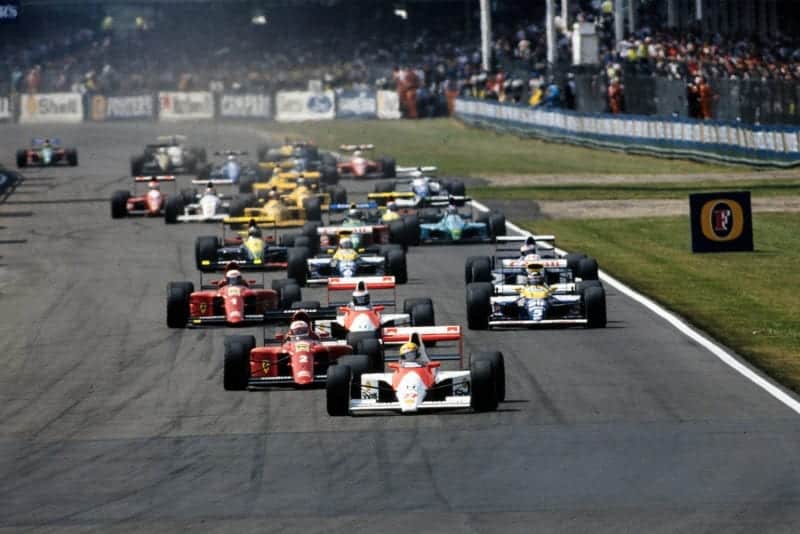
Ayrton Senna leads at the start of the British Grand Prix
Motorsport Images
Silverstone was in a magnificent mood through Friday and Saturday, covered by a clear blue sky with the sun blazing down, magnificent for the vast crowds of spectators who attended the practice and qualifying sessions, but a bit too hot for the competitors. On paper on Friday the McLaren stranglehold on qualifying looked to be secure, with Senna first and Berger second, but in truth there was not the supremely confident air about the McLaren pits that we have seen in the past. The whole Ferrari entourage had a bigger and more menacing air about it than we have seen before. Both Prost and Mansell had two complete cars each, basically one for race preparation and one for qualifying preparation, the latter cars with higher output engines specifically for a few ultrafast laps.
There was no question of special engines to install for the afternoon runs, there were complete cars set up and ready to go. As at the French Grand Prix the Ferrari pits were kept clear of any extraneous people, and ruthlessly so. Press people, photographers, television people, PR people were kept out, the Ferrari mechanics should work without intrusion.
The whole demeanour of the Ferrari team said ‘Fiat-Turin’ rather than Ferrari-Maranello’ and Fiat were out to beat Honda; it seemed as if Ferrari and McLaren were of secondary importance! This atmosphere began to become noticeable at the San Marino GP at Imola, and had been gaining credence ever since.
Although Senna and Berger were first and second Mansell was a bare quarter of a second behind Senna and the McLaren team seemed more conscious than usual of ‘the firm next door’.
On Saturday the weather was superb and the spectator turn-out to watch qualifying would have satisfied some Grand Prix organisers as a race-day crowd. A big majority had clearly come to support Mansell in his quest to win his home Grand Prix and he served them loyally. On Friday Senna’s temporary pole position time had been 1.08.071 and it had been on the cards that he would break into the 1.07 bracket, but the higher temperature on Saturday seemed to have put paid to the idea. A number of drivers got into the 1.08 bracket, but Senna was not with them, relying on his Friday time for the grid. Then Mansell went out in the Ferrari, bursting with determination and fired by the obvious enthusiastic support he had from the home crowd. It was a truly shattering performance, the cockpit almost exuding the red mist of aggression, and the result was 1.07.428, an average speed of 158.569 mph, the Ferrari nudging 170 mph through Woodcote and nearly 190 mph down Hanger Straight. Everyone knew that conditions were ‘slower’ on Saturday than on Friday, for the McLaren’s best was only 194 mph, whereas they had recorded 199.8 mph down Hanger Straight on Friday afternoon, but Mansell clearly had not been paying attention! He was in a class of his own, the only driver to get below 1.08, and he was well below. Both Senna and Prost went out again, but Mansell was beyond reach, even for Senna.
This excitement at the front left little time to pay attention to the rest of the field, even though there were some great things going on, everyone enjoying the sheer unadulterated speed of the Silverstone circuit. Even the tail-enders were going over 180 mph down Hanger Straight and more than 160 mph through Woodcote. If sheer speed gives you excitement then Silverstone was the place to be.
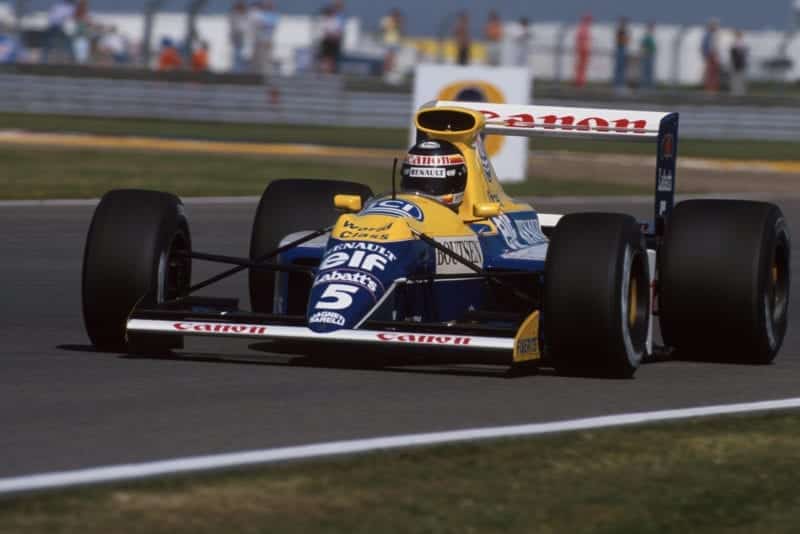
Thierry Boutsen in the Williams
Motorsport Images
In the final reckoning there was a good bunch of established fast drivers up at the front of the grid, with V12 or V10 engines, but in amongst them was a Brian Hart prepared production Cosworth V8, much to the embarrassment of the works Ford sponsored Cosworth engines. Of course it was in the blue and white Tyrrell 019 of Jean Alesi. Also near the front were two Lamborghini V12 powered cars, though not the Lotus 102 cars of Derek Warwick and Martin Donnelly, as all true patriots were assuming, but the Gerard Larrousse pair of Lola L90 cars driven by the young and unobtrusive young Frenchman, Eric Bernard and the even more unobtrusive Japanese driver Aguri Suzuki. Just behind this pair came Ivan CapeIli in the first of the turquoise Leyton House Judd powered cars and his team-mate Gugelmin was not too far behind.
The gap between pole position and the last man on the grid continues to widen and for the British Grand Prix it was over four seconds, while the last of the four non-qualifiers was nearly six seconds behind. We seem to be fast reaching the point where the 10% gap rule will start having its effect on the starting grid.
Tyre wear as such was not going to play such an important part in the outcome of the race as had been prevalent at the French Grand Prix, but nonetheless the fast runners at the front were all conscious that a tyre stop may be needed.
Sunday morning warm-up caused something of a stir, for the Ferraris were still at the top of the list, but Piquet was also up there in his Benetton, with a new Mk IV Cosworth works engine installed, and Nannini had one in his Benetton as well. The McLaren-Hondas were down in fourth and fifth places of this race-morning ‘temperature’ chart.
During the morning the circuit filled with a capacity crowd of an estimated 100,000 people and with a haze over the sun that kept the temperature comfortable, we looked to be in for some interesting racing. Between the warm-up half-hour that finished at 10am and the 2pm start there was non-stop entertainment for everybody, from races to demonstrations on the track, to performances in the air, accompanied by a non-stop welter of chat and information over the public address system, and strategically placed vast television screens that projected non-stop racing videos as well as direct TV transmissions. There was also the very busy attraction of eating and drinking. Time never drags once the British Grand Prix programme gets underway at 8am on Friday morning, and as the pit-lane opened to let the 26 competitors for the Grand Prix out onto the track the whole gigantic show and entertainment reached its climax. The British Grand Prix was about to happen.
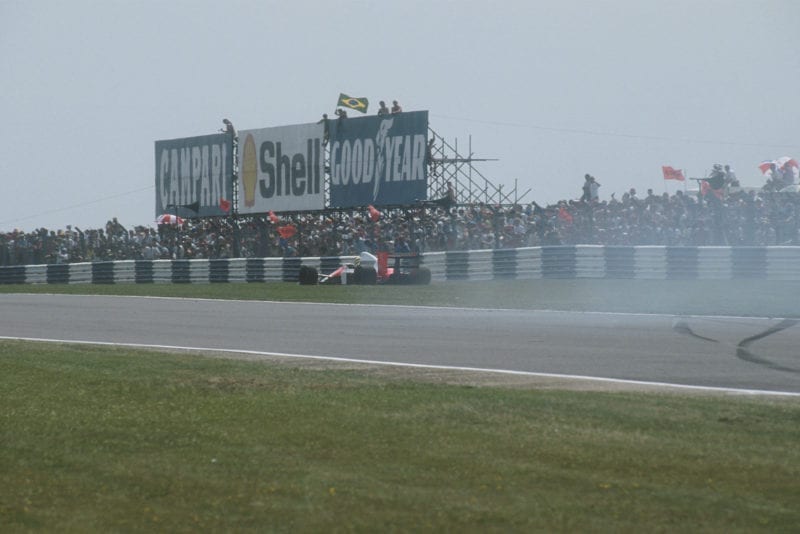
Senna slides off the track after a spin
Motorsport Images
Once lined up on the grid there was the usual period of waiting until everything was ready for the parade lap but as Mansell was given the green flag to lead the field gently round on the lap of reconnaissance disaster struck two of the competitors. Piquet’s Benetton was reluctant to start and he was left behind, and Gugelmin’s Judd V8 died on him. Eventually the new Cosworth unraced works engine fired up and Piquet caught up the tail of the field, but there he had to stay as the Formula One rules forbid you to regain your grid position if you do not start the parade lap correctly. Poor Mauricio Gugelmin was out before the race got near to starting, as the fuel pump drive on his engine had failed. Barilla had also been late away on the parade lap, but as he was near the back of the grid anyway it did not affect him unduly, but Piquet had to line his Benetton up right at the back.
In spite of Mansell having a 7 metre advantage on the staggered grid line-up over Senna, it was the Brazilian who snatched the lead on the opening lap from the Ferrari, with Berger and the rest following in grid order apart from one or two minor changes in mid-field. At the back Piquet overtook five cars on the opening lap and set about making up for his handicap. It only needed a couple of laps for the situation at the front to make itself clear, for though Senna was in the lead he was not pulling away from Mansell, though the pair of them were out on their own. For twelve glorious laps the Senna/Mansell battle held everyone’s attention for the Ferrari driver was in his best fighting ‘mode’ and wasn’t giving away an inch. He wasn’t just ‘hanging on’ to the McLaren-Honda, he was fighting it and as the two cars pulled out a lead over the rest of the field the crowds on the back part of the circuit could enjoy the wonderful sound of the V10 Honda and V12 Ferrari on full song down Hanger Straight, through Stowe corner and down to Club corner before the rest of the pack of confused sounds interrupted, and even from Abbey Curve the sound was glorious as it wafted across the open space. On lap 9 Mansell had the Ferrari almost touching the tail of the McLaren as they breasted the rise at Abbey Curve at what must have been 180 mph. Into the braking area for the tight left hand bend of the Woodcote complex he was alongside but badly placed for what was to follow and while he sorted himself out Senna continued in the lead. Lap 10 saw the McLaren with a slight advantage, though on lap 11 Mansell was having another go, but Senna was not giving in, and on the next lap Mansell was really determined, and this time he snatched the lead, acclaimed by a roar of support from the crowd that he must have almost heard above the scream of the Ferrari engine.
That Senna had the McLaren on its absolute limit in trying to cope with the Ferrari was shown on lap 14 when he lost it coming out of Copse Corner, and spun. As he gathered it up Berger, Boutsen and Prost went by and later the number two McLaren driver told how it was no surprise to see Senna spinning, as his own McLaren felt very ‘light and nervous’ and he was expecting to lose control all the time.
It was becoming clear that the engine development at Ferrari (Fiat) was seriously challenging the Honda V10 power, and McLaren no longer had the advantage of a surplus of power that they could utilise to overcome drag-inducing downforce in their attempts to cover up any chassis deficiencies over some of their rivals, notably the Ferrari. If you have to gain speed by reducing drag and downforce your handling will suffer and the car will feel ‘light and nervous’, which is what both McLaren drivers were experiencing. While aerodynamics and tyres are all important in the overall package of a Formula One car, the engine is still the heart of the package and the basic parameter of all the other things you do to extract the maximum from the car.
To get back to the race, Mansell now had a comfortable and unchallenged lead, for Berger just was not up to it, though he was fairly secure in second place ahead of Boutsen, for the Williams driver did not look as though he was going to produce anything spectacular.

Alain Prost leads Ferrari team-mate Nigel Mansell
Motorsport Images
Spectacular this day was Nigel Mansell. In fourth place was Alain Prost, at first content to watch the Senna/Mansell battle from afar, but now leaning very heavily on Boutsen’s Williams as he decided it was time to start moving nearer the front. He was soon past the Belgian driver and that indicated that Prost had decided he was going to win this race. Although he never looks particularly fast you can somehow read his plan by the way he makes his moves. Normally there is nothing particularly aggressive about his driving, but his outward calm occasionally turns to hard determination in the way he overtakes someone and then you know he has got the whole situation well worked out.
By lap 20 Senna had dropped from 5th to 10th, as he had been forced to make a pit-stop for a new set of tyres, having put ‘flats’ on his existing set as he had spun and Mansell was now lapping the tailenders, during which process Berger and the rest began to close up. The Ferrari electronic control system of the 7-speed gearbox was causing Mansell some problems, as it did not always respond correctly to signals being sent down from the steering column lever-switches and on lap 22 Berger snatched an opportunity to nip into the lead for a few laps, but Prost now had his team-mate in sight, and the sight of Alain Prost in your mirrors is never very comforting. It is like it used to be with Niki Lauda in his Ferrari days; the sight of the Austrian in your mirrors was not a good thing.
On lap 28 Mansell was back in the lead, having past car number 28 (playing the numbers game) but four laps later Prost was through into second place and the McLaren rout was complete. Even more sinister was the conviction that Alain Prost was going to win this race, even at the expense of the British hero, because he was not sitting back and watching Mansell enjoy his well-won glory, he was getting closer and closer, and that meant only one thing.
For 12 laps the Ferrari duo were in complete command of the race, having destroyed the main opposition, not by luck or good fortune, as has happened in the past, but by clear superiority on numerous counts. If Gerhard Berger’s future lies in his racing performance then we must accept that his future looks bleak, made all the worse when it became apparent that his third place was far from secure. Almost unnoticed due to the excitement at the front of the race, the mid-field had been full of interesting happenings, and as the front began to crumble the mid-field runners were becoming an integral part of the front. Of particular interest was the progress of the turquoise car number 16, that of Ivan CapeIli, and car number 30 that can only be described as multi-coloured. The Leyton House driver and Aguri Suzuki, for that is who it was in the Lamborghini-powered Lola of the Larrousse team, were closing on Boutsen’s Williams-Renault, but to add interest, Nelson Piquet was now up to 7th place from his back-of-the-grid start, and still gaining ground.
The other Larrousse car, driven by Bernard was also in the vicinity, followed by Donnelly in the yellow Lotus-Lamborghini, but they had Senna closing in on them after his tyre-stop. In spite of a cracked exhaust pipe the Leyton House Judd V8 was going well, and CapeIli was lapping as fast as anyone. As Piquet caught and passed Suzuki, to take sixth place, CapeIli caught and passed Boutsen to take fourth place, and Senna caught and passed Bernard to take eighth place. Although this was all a bit confusing it could hardly be said that ‘nobody ever passes anybody in Formula One’ as detractors of Formula One (who seldom go to watch the racing) are always saying. For the 100,000 paying spectators there was plenty happening, even if some of it was somewhat difficult to explain.
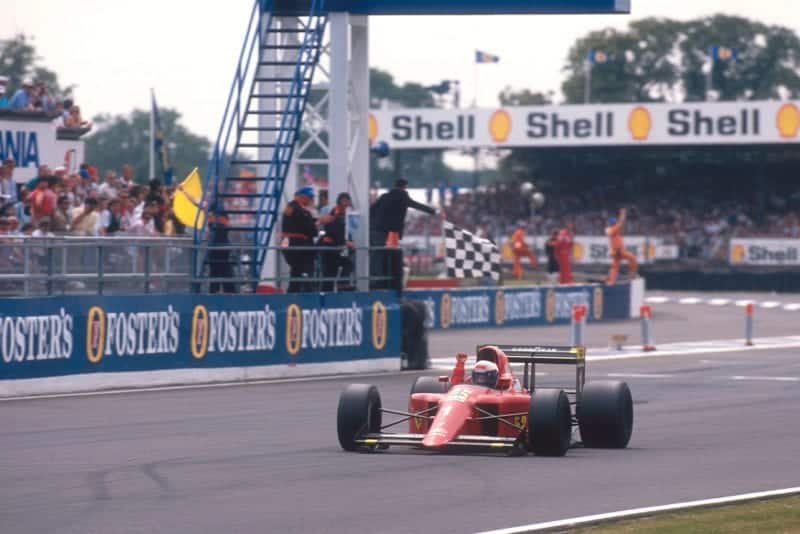
Prost takes the chequered flag to win
Motorsport Images
The Ferrari 1-2 was clear enough to anyone, even though in fact it was car number 2 leading car number 1, but the sight of CapeIli moving up into third place, passing Berger on lap 44, was something that was difficult to comprehend, but few people were complaining about it for you could just imagine the happy smile on Ivan CapeIli’s face. This diversion almost overshadowed the fact that the Ferraris were now 1-2 in the order 1-2, for Prost had moved quietly (!) by his team-mate, the troubled functioning of the gearbox getting worse for Mansell.
CapeIli’s joy at being third was shortlived as the Leyton House broke a vital fuel pipe and the sleek turquoise car disappeared from the scene, much to Berger’s relief, who moved back into third place. Piquet’s relentless drive through the field was now hampered by the fact that Senna was catching up fast so Boutsen’s tenuous 4th seemed fairly insecure. On lap 56, with the end almost in sight, Mansell’s car lost all its drive to the rear wheels as he went into Copse Corner and he free-wheeled off the track and out of the way to another dejected retirement, wondering why Prost never seems to have these sort of mechanical failures. We used to say that Niki Lauda drove with a velvet touch, and Alain Prost certainly does, and he purred his way on to victory, his third successive one for Fiat (or do I mean Ferrari?).
Purely by the default of others Boutsen came home in second place, and Senna finished third, both promoted up a place when Berger’s McLaren disappeared on lap 61, three before the end, when the throttle-butterfly mechanisms malfunctioned, and there are ten of them controlled by a pretty complex mechanism between the cockpit and the engine! In the dying laps Piquet had a quick spin, and the Benetton-Cosworth tried hard to die but Nelson kept it going, though he was passed by Bernard’s Lola-Lamborghini on the penultimate lap. Bernard had inherited his team-mate’s place when Suzuki’s car suffered a puncture and he had to limp round to the pits for new tyres, finishing 6th one lap down on the winner.
Alain Prost has now won so many more races than Jackie Stewart, who established some sort of record long ago, that it seems pretty academic to keep on adding up the score. As so often happens he wins in the end after starting in what seems a hopeless situation, which is his style. One day we may see him lead a race from start to finish, from pole position on the grid, but we will have to get rid of Mansell, Senna, Berger and a few others before that happens I feel.
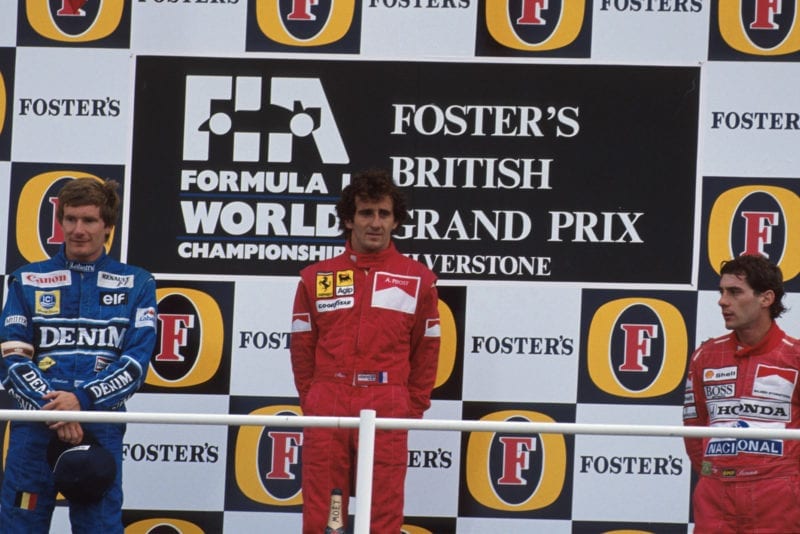
Prost stands on the podium alongside Boutsen and Senna
Motorsport Images
One may well ask what happened to a lot of very fancied runners within the field of 26 cars. Jean Alesi started off in a hard-charging sixth place with his Tyrrell but simply went too fast, too soon and had to stop and change his Pirelli tyres and thereafter did not feel confident about the car’s handling ending up a very unspectacular 8th. The performance by Team Lotus is best forgotten, especially as it was their home Grand Prix. Both cars were led by the Larrousse Lolas throughout the race, though Martin Donnelly was doing his best to keep up, but as his Lamborghini V12 engine expired at Abbey Curve on lap 49, Warwick’s yellow car was being wheeled back off the circuit by marshals a hundred yards up the road, having succumbed to engine failure two laps earlier. Meanwhile the Lamborghini V12 engines in the Lolas never missed a beat; there has to be food for thought in that fact. Patrese got hit up the back by Nannini as he was slowing to head for the pits for a tyre change, though neither of them were in the running, and Alboreto retired from an obscure place at the back when his engine failed, though Caffi kept his Arrows going well and finished 7th, ahead of Alesi.
As a ‘Three Day Grand Happening’ the Silverstone event was a huge success, almost too huge at times, but no-one could say there had been any dull moments from dawn to dusk, and on into Sunday night and Monday morning for the campers and party goers.
Of particular importance in the history of Grand Prix racing this was the last race to be held on the Silverstone airfield circuit, for next month work starts on transforming the circuit into something new and interesting without losing any of the high-speed attraction of the circuit that has been used for more than forty years. To McLaren-Honda the weekend had been an unmitigated failure, bordering on disaster, with only second place on the grid, and third place on the winner’s rostrum at the end of it all. By their exacting standards it was something to be mortified about; to many other teams it would have been a roaring success and a time for jubilation. Racing is hard enough, winning is even harder, but to stay winning is hardest of all. DSJ
